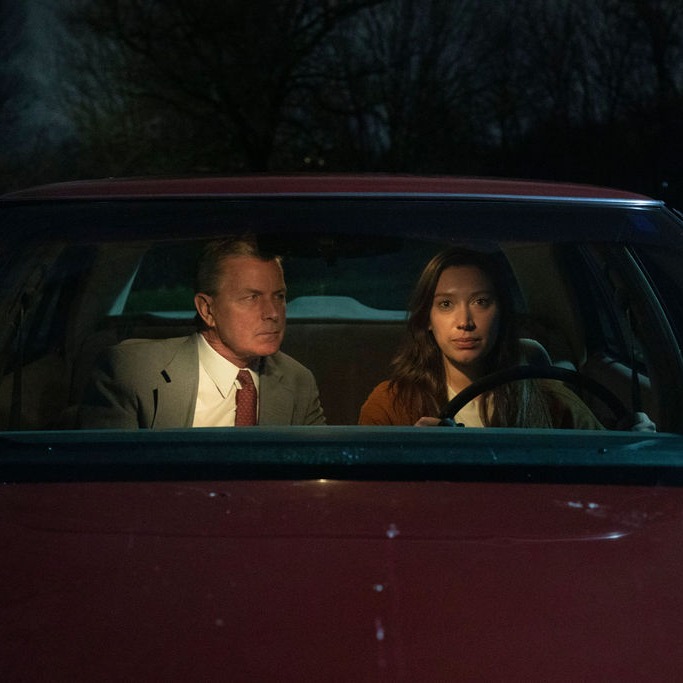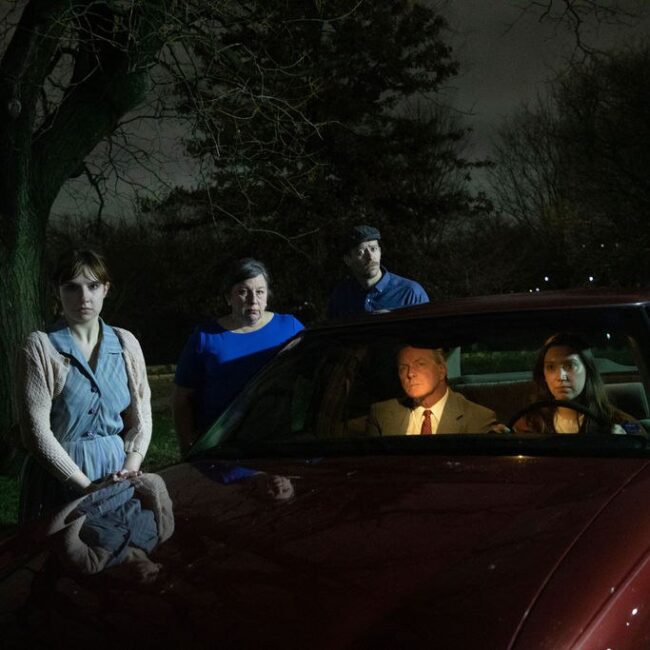One might think that a play with a title like How I Learned to Drive would depict a story that goes places; and by its own design, this is a play that goes many places and goes in circles (while in reverse) at the same time. But that being said, while funny and well told, Paula Vogel’s Pulitzer Prize winning play How I Learned to Drive is not for the faint of heart.
And so before I continue any further, a disclaimer. This production comes with a lot of content warnings, so buckle in.
While How I Learned to Drive (directed by Tessara Morgan Farley) is a play with humor, it also deals directly with subject matter related to sexual harassment, sexual abuse, grooming and pedophilia, misogyny, and incest. But while it tackles these sensitive and disturbing subject matters, it does so with unflinching honesty while weaving a complex winding narrative that will leave a lasting impact on its audience.

The story itself centers around Li’l Bit (played by Sydney Marks) as a young woman in her 30’s grappling with the emotional scars left by her complex relationship with her Uncle Peck (played by Doug Krehbel) as she processes her childhood memories associated with her uncle as he (you guessed it) teaches her how to drive. Vogel artfully uses a fragmented and asynchronous narrative structure as Li’l Bit recounts her memories out of order, but always associated with the titles of chapters found in a driving manual. As the story jumps back and forth, the audience goes along for the ride from seemingly innocent car rides in the countryside to moments of increasing discomfort and manipulation. While uncomfortable at times, and likely triggering to some, the play avoids ever sensationalizing the abuse, and instead opts for a more nuanced portrayal that emphasizes the power dynamics and emotional complexities engulfing Li’l Bit, while also feeling disjointed in such a way that feels almost removed from the situation just as Li’l Bit would at times feel out of her own body.
Costuming (designed by Liz Dunlap) is at all times modest. But then that’s a point in and of itself: those victimized do not need to be dressed provocatively to be targeted. While the story is set in rural Maryland, the set itself (also designed by Farley) is sparse and simple with naught but a few surrounding walls with ripped and deteriorating wallpaper and a single window to adorn them. Only a few simple cushioned kitchen chairs and a kitchen table are used about the stage to invoke the feeling of a car, or a family kitchen, or an Eastern Shore restaurant. In this way, the staging environment is simple so as to provide nothing to distract the audience from the memories as they unfold. But at the same time, there is also nothing that would allow the moment to feel too real, or too encompassing for audience members that may need that ability to feel removed from the moment being depicted. The sparseness of the set and props allows the audience to fade in and out of Li’l Bit’s memories as they come and go, and simultaneously feel detached.
And while having the ability to become detached at times may be a valuable ability in traumatic situations, it is difficult to detach oneself from the outstanding performances by the entire cast. Marks’ and Krehbel’s rapport feel natural and complex, making it easy to sympathize with the connection Li’l Bit feels for her uncle, but also recognize the malicious grooming and manipulation at play that wraps and ensnares her.

Marks excels in her role as she tackles head-on the intricacies of her character being played as an adult recounting her teenage, young adult, and 11 year-old self. In each life stage, Marks captures the essence of both youth and naivete associated with each age, while also regressing into a younger self each time that has not yet learned the lessons of her older self played in the scenes before. You can see the nuance in Marks’ performance as Li’l Bit grapples with the desire to be seen as anything more than her developing body, while also simultaneously seeking the love, attention, and acceptance denied to her by the rest of her family.
Krehbel is a man that understands the true villainy of his character. He is charming and approachable and attentive in a way that allows others around him to feel both at ease and seen all at once. There is an effortlessness to Krebel’s “Southern Gentleman” performance that allows the audience to see how manipulative Uncle Peck’s behavior and mannerisms are in such a way that shines a light on just how simple and mundane predators can be as they plant the seeds of trust they will later sow as they groom their victims.
But while Marks and Krehbel take most of the focus on stage, the Greek Chorus is there to provide a laugh here and there or help illustrate the harmful family dynamic imposed on Li’l Bit as she journeys through puberty on her own. Or to watch the events unfold between uncle and niece, and do nothing.
The Male Greek Chorus is played by Lucius Robinson, and while Robinson has the task to play every male character other than Uncle Peck, he does so with aplomb and graceful humor. I can’t remember the last time a martini glass made me laugh! The Female Greek Chorus is played by the powerful Melissa Banister who does not shy away from being a character. Whether chiming in to humorously give a lesson on how ladies should handle their alcohol, or somberly stepping to center stage to chide and victim-blame a child for a predatory adult’s behavior, Banister commands without detracting the flow of the story. Finally, the Teenage Chorus played by Morgan Wenerick will break your heart with her part in “the initial incident.”

In case it was not apparent from the show’s synopsis and content warnings, it is important to stress that this play’s subject matter may be triggering for survivors. It is crucial to consider your own emotional well-being before attending a performance, but even so, Vagabond Players is sensitive to this and provides a series of resources in your program if after the production you need resources for support.
It’s sad to think that a play, written in the 90’s, that takes place in the 60’s and early 70’s, that is told by a character living in the 80’s, could still feel so relevant in today’s 2020’s. For the future’s sake, I pray that those that do resonate with How I learned to Drive are the last and things really do improve with each generation. But overall, How I Learned to Drive is a powerful story about processing and surviving trauma, and this thought-provoking play deserves to be seen. While challenging, it is a rewarding experience that will stay with you long after your drive home.
Running Time: Approximately 1 hour and 40 minutes; presented without an intermission
How I Learned to Drive plays through March 10th, 2024, at Vagabond Players— located in the heart of Fells Point: 806 S. Broadway in Baltimore, MD. Tickets can be purchased by calling the box office at (410) 563-9135 in advance online.
